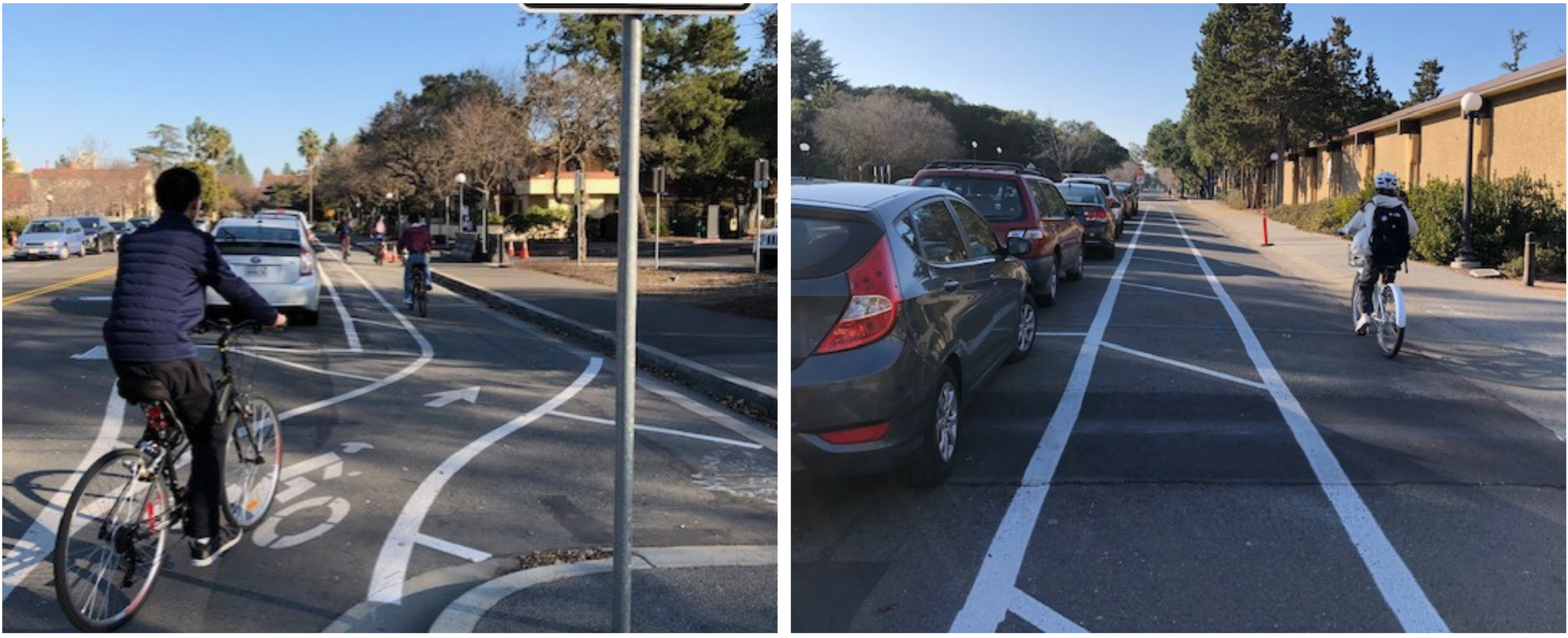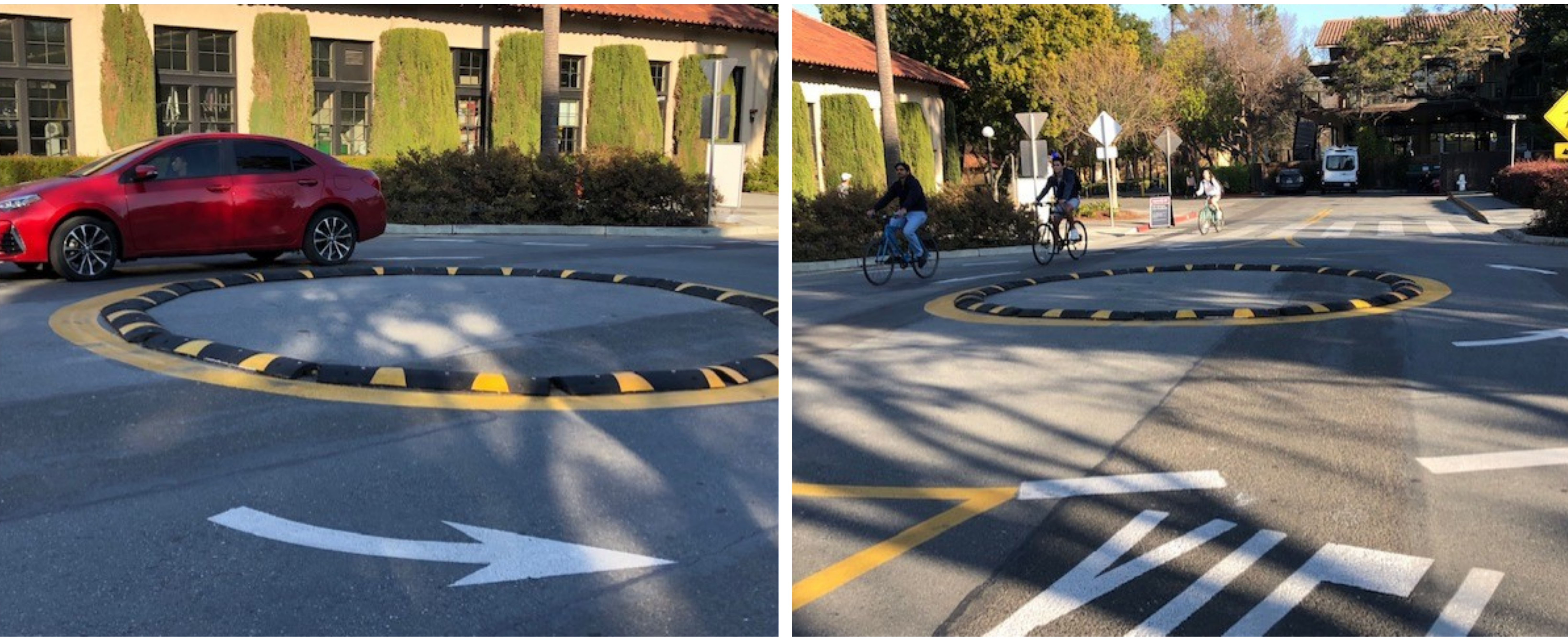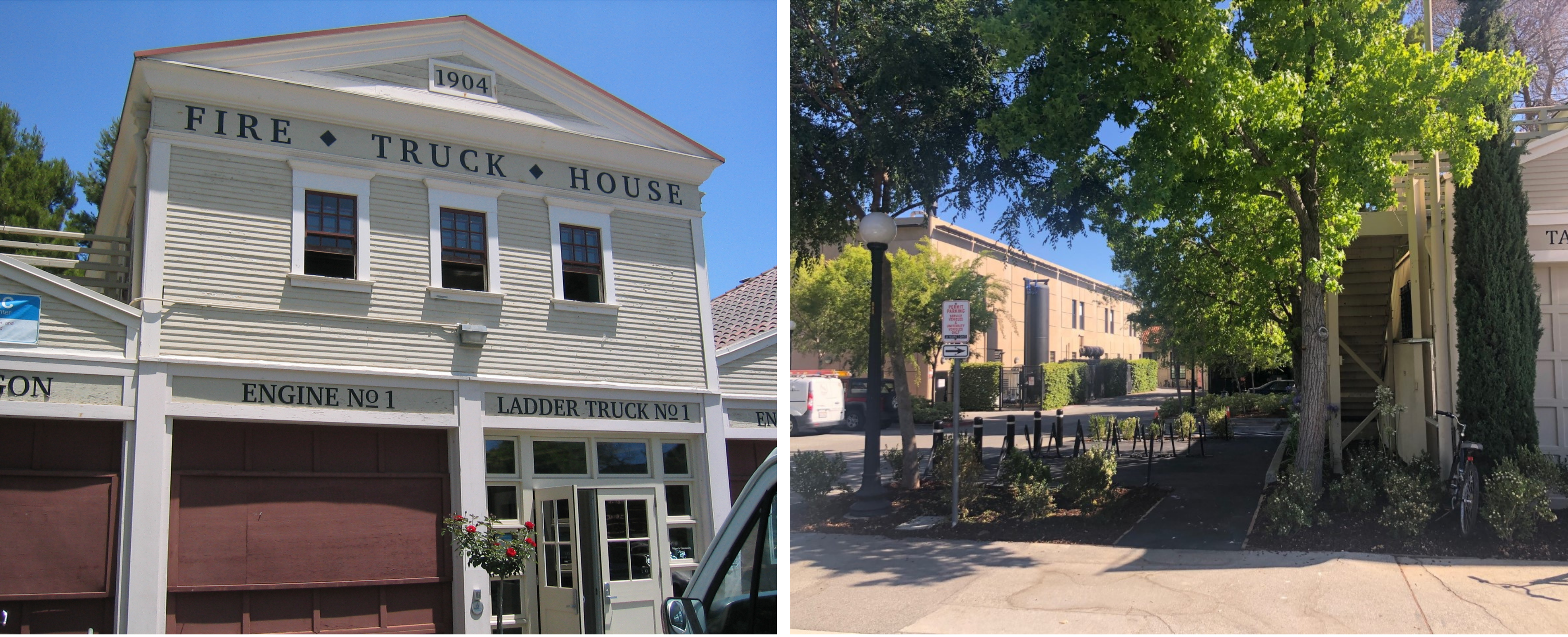[Published: Feb. 10, 2022]
Have you noticed the new roadway safety pilot on Santa Teresa from Lomita Way to Duena Street? While you were on winter break, Campus Planning & Design and the Department of Project Management along with support and input from Stanford Transportation, Stanford Public Safety, and the Stanford Diversity and Access Office, painted separated bike lanes, changed how cars are parked, and added a vehicle turnaround on this widely traveled corridor. This temporary installation will be evaluated over the next year. Based on campus feedback, it may lead to a permanent implementation.

WHAT’S HAPPENING?
This pilot aims to increase safety for pedestrians and cyclists, improve traffic circulation and make all who travel along this section of the roadway more visible. Here is what has changed and why:
- The new separated bike lanes are exclusively for bicyclists. They are distinct from the sidewalk and physically separated from cars with a buffered lane or parked vehicles.
- Cars no longer back out of parking spaces and interfere with cyclists traveling in the same direction.
- Pedestrians and those with mobility impairment have their own dedicated path.
- The turnaround keeps traffic flowing; all users have a better view of oncoming bicyclists, cars, and pedestrians.

To create bike lanes separated by a buffer of parked cars, Campus Planning & Design and Project Management swapped out existing head-in car parking toward the curbs along Santa Teresa for parallel parking. This change not only insulates bicyclists from cars traveling on this section of roadway, but it also assures that bicyclists won’t get “doored” by a motorist opening a car door too quickly without looking. An additional driveway entry and exit on Santa Teresa was also removed to minimize cars entering and exiting onto the street.

Street to turn around.
“I use the new lanes every day on my way to and from Roble Hall,” Hallie Rose Mikacich, '23, who serves as a member of Stanford’s Transportation Bike Safety Committee. "The new bike lanes have made a dramatic difference. It feels a lot safer not having to navigate cars that are sharing the road and that might have to back up towards you. There are other routes to my dorm, but this is the most direct, so I often took it even when it wasn’t as safe. Now I feel a lot better going that way.”
In addition to the new separated bike lanes, a bike rack compound with 32 bike parking spaces was added next to the Fire Truck House, home of the QSpot.

HOW CAN I GIVE FEEDBACK?
The separated bike lanes are a temporary build so Stanford Campus Planning & Design can observe user behavior and gather feedback on the design. The project will be evaluated and improved before the pilot becomes finalized. If you’d like to offer feedback on any of the temporary features installed via paint, we would love to hear from you! Send comments to circulation@lists.stanford.edu.

WHY PROTECTED BIKE LANES?
Protected bike lanes are like “sidewalks for bikes,” according to PeopleForBikes, the national organization dedicated to improving biking for all. Planters, curbs, parked cars, or bollards are typically used to separate bikes from car traffic on busy streets. These separated lanes are an essential part of building a network of bike-friendly routes that makes biking pleasant and practical for many types of riders (not just the bold or athletic).
It’s not just PeopleForBikes who think separated bike lanes are revolutionary. The National Transportation Safety Board claims they are game-changing, proven, effective, and a simple innovation.
Last November, the NTSB even called for separated bike lanes to be included in the Every Day Counts program. Every Day Counts is a program “that identifies and rapidly deploys proven, yet underutilized innovations to shorten the project delivery process and enhance roadway safety.” Its findings include:
- European cities and countries with high rates of bicycling and incredible safety records attribute those successes to bicycle infrastructure, particularly separated bike lanes.
- A review found separated bike lanes constructed in the U.S. increased bicycle ridership and influenced cyclists to behave more predictably. Multiple international reviews show that separated bike lanes decrease the risk of injury and lower the severity of injuries that do occur, in part because they eliminate hit-from-behind crashes that disproportionately kill cyclists.
- Many states have yet to install them on state roadways and fewer than 100 cities have one installed.
- Nationally, New York City leads this metric with more than 124 miles of protected bike lanes. On a local level, San Francisco currently has over 42 miles of protected bike lanes.
WHY THIS PILOT?
Campus Planning & Design collaborated with Stanford Project Management on the pilot program, along with support and input from Stanford Transportation, Stanford Public Safety, and the Stanford Diversity and Access Office. Here’s what our leaders had to say:
“We first want to test, then refine, especially based on feedback from users, before we make any permanent changes,” said Cathy Blake, University Landscape Architect and Director, Campus Planning, Land, Buildings & Real Estate (LBRE).
“Collaborating with our safety partners, we continue to strive toward improving safety for all road users on campus,” said Ariadne Delon Scott, Assistant Director of Active Mobility at Stanford, who manages the bicycle program, nationally recognized as a Platinum Level Bicycle Friendly University. “It’s not just about awards. It’s about saving lives, reducing risk, and increasing awareness of how to get around the campus safely.”
Shelia Sanchez, ADA Program Director, Diversity & Access Office, shared that "Dedicated bike lanes create a solution that not only offers safety to cyclists, but they also standardize some of the cyclists’ behaviors. This means that vehicles, pedestrians, including those with disabilities, won’t have to guess how the bikers will navigate the road or sidewalk."
Bill Larson, Crime Prevention and Community Safety Programs Manager, with Stanford Public Safety commented, “This pilot was designed to improve circulation and safety, which is only as safe as everyone complying with the vehicle code (e.g., signs and road markings). This also applies to a roundabout such as the requirement to YIELD to traffic in the roundabout before entering.”
For more information and questions, email bike-information@stanford.edu.
